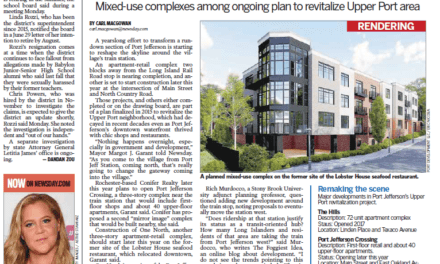The following was exclusively published by The Foggiest Idea on June 30, 2020. This piece was honored with a second-place prize for real estate reporting by the Press Club of Long Island in their 2021 PCLI Media Awards competition. Interested in supporting The Foggiest Idea’s award-winning reporting and analysis? Click here.
By Richard Murdocco
New Yorkers waiting eagerly for live-action sports to resume locally after the pandemic restrictions are lifted just got blindsided by the owners of the Nassau Coliseum who suddenly announced in the middle of June that the once-venerated venue where the Islanders won four straight Stanley Cup championships will be closing indefinitely.
The power play comes as billionaire owner Mikhail Prokhorov and his company, Onexim Sports and Entertainment, seek out new investors to take over the Coliseum’s lease. The challenge will be to convince them that investing in a down-sized 13,000-seat arena stuck with $100 million in municipal debt makes financial sense, especially as a new $1.3 billion facility for the New York Islanders is being built 15 miles away at Belmont Park. The Isles’ new home will come with more than 17,000 seats.
Although unexpected, the closure isn’t all too surprising given how the venue’s handling has been so bungled in recent years. Quite frankly, the Nassau Coliseum has had a rough second-act during the 21st century.
The most high-profile failure was Charles Wang’s overly ambitious $3.8 billion Lighthouse Project. First unveiled during a September 2004 news conference, the proposal called for a renovated Coliseum for the Islanders, which Wang then owned, as well as the creation of “Long Island’s signature destination” with a Grand Canal, a Celebration Plaza, and the gleaming double towers of a five-star luxury hotel soaring 60 stories above the Hempstead Plains. Known as the Nassau Hub, the 150-acre site and the surrounding area in Uniondale would get an additional 2,306 units of housing, 1 million square feet of office space, and 500,000 square feet of retail. The project was shot down by the Hempstead Town Board in 2010.

Pictured: An artist’s rendering of Charles Wang’s proposed Lighthouse Project plan. (Source: Handout)
Next up was the cockamamie 2011 scheme by then-Nassau County Executive Edward Mangano to have taxpayers float the cost of a new arena to the tune of $400 million. Nassau voters overwhelmingly rejected the referendum to borrow the money by 57% to 43%.
Following the defeat, there was a faceoff in 2015 between Bruce Ratner, a Brooklyn developer who then owned the Coliseum as well as Barclays Center, and Syosset-based Blumenfeld Development Group, both of whom were looking to build $261 million worth of mixed-use projects that would include a downscaled arena, a 1,500-seat movie theater, and retail on the Hub’s vacant swaths of asphalt. Their litigious cross-checking continued even after the Feinstein Institute for Medical Research backed out of a proposed $300-million facility that was slated to serve as an anchor project of a blossoming bio-tech sector.
Despite many failures, some progress was eventually made. After their lease at the Coliseum expired in 2015, the Islanders took their pucks to Brooklyn, and the Nassau venue underwent a $165-million face-lift, complete with $6 million coming directly from New York State for necessary upgrades so that the Islanders could once again come back to play ice hockey in Nassau County. Nearby, Memorial Sloane Kettering broke ground in January 2017 on MSK Nassau, a new $180 million 114,000 square foot cancer care center. The facility opened in April 2019.
In addition to the renovations, RXR Realty developer Scott Rechler was in the midst of working on a $1.5-billion project that called for 500 units of housing, 600,000 square feet of office and biotech research space, 200,000 square feet of “experiential retail,” 3,400 parking spaces, rapid transit links to both the Mineola and Hempstead LIRR stations, and two new pedestrian bridges.
Things seemed to be back on track as the Islanders split their time on the ice between the Nassau Coliseum and the Barclays Center this past season. The NHL team had already committed to playing the 2020-2021 season “back home”—as they put it—while the new Belmont arena was being built.
This sudden closure could throw that all out the window.
Rechler is now revisiting his plans. He’s told Newsday’s Randi Marshall that his company still wants to build in the area.
“RXR remains committed to the project and has been spending a significant amount of time reimagining what the site will look like in this post-pandemic world to help Long Island reignite its economy,” Rechler said.
Nassau County Executive Laura Curran is hoping for the best—and waiting on the bench.
With pandemic putting a strain on the county, the administration hasn’t been particularly forceful on the issue. This stance has to change, especially as a property that arguably serves as an economic linchpin for the entire county now sits idle. To be successful, Curran has to personally task herself with ensuring that this critical project doesn’t once again fall victim to the squabbling of billionaires and the typical politicking that has sunk the venue’s past ambitions.
Curran’s office told TFI they are confident things will move ahead, but didn’t specify exactly how.
“Nassau County is encouraged that Onexim is speaking to their lenders and other potential investors, and we remain focused on development plans with RXR Realty, a strong and committed partner on this project,” Curran’s press office said in a recent statement. “Transforming the Hub site, important before the pandemic, is now even more critical to Nassau’s economic comeback. We have momentum, and the collaboration of community stakeholders, elected leaders, business and labor, to ensure our success.”
Despite the optimism, significant questions remain.
If the Coliseum remains closed and the Islanders are not able to play in Nassau for 2020-2021, what, if any, return do New Yorkers get on their $6 million investment? After all, they had no real say on this public spending. In addition, if Prokhorov doesn’t think the Coliseum can cut it, what does that closure mean for Suffolk County’s efforts to build a new arena in Ronkonkoma? That mixed-use project near the LIRR train station involves a 7,500-seat hockey arena, a 6,000-seat outdoor stadium, and a huge convention center along as well as a new hotel, and office and retail space.
Kristen Jarnagin, the head of Discover Long Island, a non-profit tourism promotion organization, is open to exploring the concept of placing a convention center in Uniondale. “I’ve always thought that Ronkonkoma is the perfect area because of the transportation access,” she told The Foggiest Idea, “but the Nassau Hub would be very desirable for that type of facility based on the existing hotels and proximity to the airports and New York City.”
To Jarnagin, the closure of the Coliseum, while a loss for nostalgic residents, won’t necessarily tank the region’s tourism economy.
“Most of the events that take place there right now aren’t drawing people outside of the region,” she said. “It’s great for local events, and the one big concern is the Islanders. That is a great tourism draw,” she added, but noted that the team was going to be gone in a year.
“We’re very hopeful that the Nassau Hub continues to move forward,” she said. “It’s an incredibly transformative project for the region, and it’s important that it continues to be developed.”
Meanwhile, Nassau County, already hurting from a $384 million hole that was torn into its municipal budget thanks to the coronavirus’s economic impact, is now facing at least another $6.32 million in lost revenue, which is what county officials estimate that the coliseum brought to the table in 2019. If the Coliseum were open and thriving, comptroller records show that it could contribute to Nassau’s coffers through payments for rent, utilities entertainment taxes and other expenses.
In the end, there is no denying that Nassau faces a tough road ahead. Any developmental effort worth its salt has to have an anchor tenant, a magnetic presence that can attract investment, people and businesses from far and wide. With the Coliseum shut down, Nassau not only faces the sizable hurdle of developing the Hub’s ocean of asphalt, but now it must define the future of the venue itself.
Richard Murdocco is an award-winning columnist and adjunct professor in Stony Brook University’s public policy graduate program. He regularly writes and speaks about Long Island’s real estate development issues. Follow him on Twitter @thefoggiestidea. You can email Murdocco at Rich@TheFoggiestIdea.org.













